With many advances in the field of bariatric surgery, new surgical methods arise regularly to improve the efficacy and outcomes of the various procedures. The mini-gastric bypass is an example of such advances.
Here are some quick facts about the mini-gastric bypass to get us started. The procedure:
- was developed in 1997 by a surgeon named Robert Rutledge
- was designed to reduce surgical time compared to traditional gastric bypass
- simplified the traditional gastric bypass by reducing the number of new intestinal attachments created
- Has been demonstrated to be a safe and effective weight loss surgery method
With all that being said, what exactly is the mini-gastric bypass? Let’s jump into all there is to know about the procedure.
What is a mini-gastric bypass?
A mini-gastric bypass, also known as a single-anastomosis gastric bypass, is a weight loss surgery procedure that has been established as a safe alternative surgical method.
The surgery is considered minimally invasive because it is performed laparoscopically in which a small incision is created and a special camera is inserted through the incision. The camera then transmits images of the abdominal cavity to video monitors that the surgeon uses for the procedure.
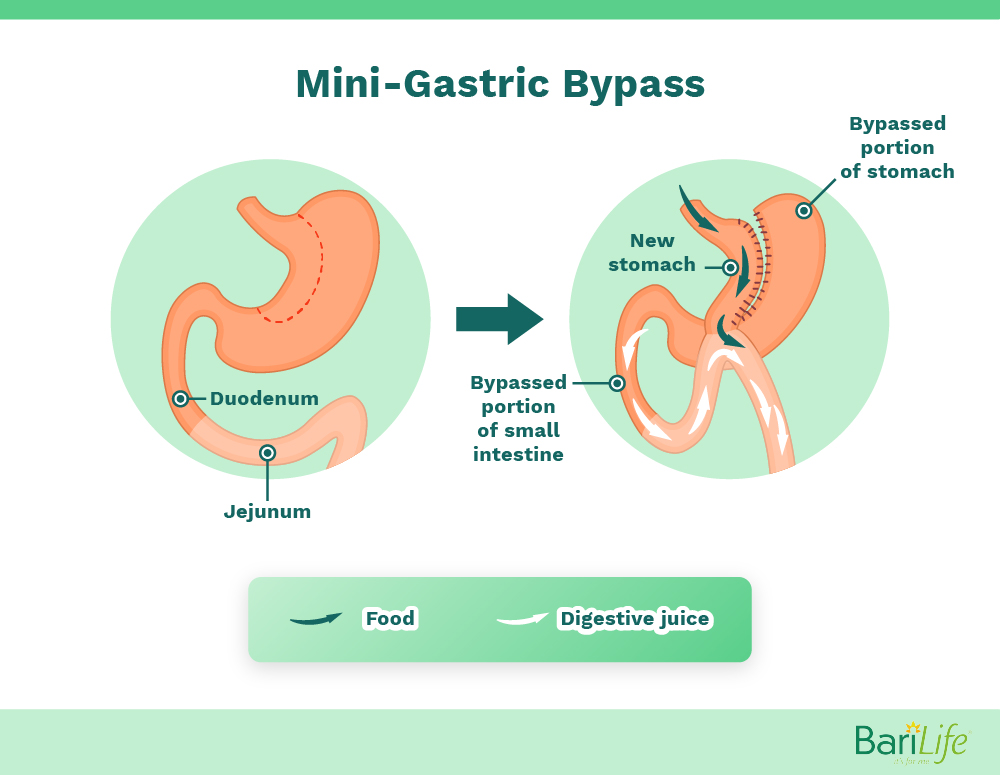
During a mini-gastric bypass procedure, the top part of the stomach is stapled off to form a thin tube that becomes the new stomach pouch. This pouch then bypasses the first part of the small intestine known as the duodenum and is attached just below. The remaining part of the stomach and small intestine that was bypassed remains in the body but is no longer functioning in the digestion process.
Mini-gastric bypass VS traditional gastric bypass
The traditional gastric bypass, also called the Roux-en-Y (or RNY) procedure serves as the gold standard of bariatric surgery, and that which the mini-gastric bypass originated from. The difference between the two surgeries lies within the procedure itself.
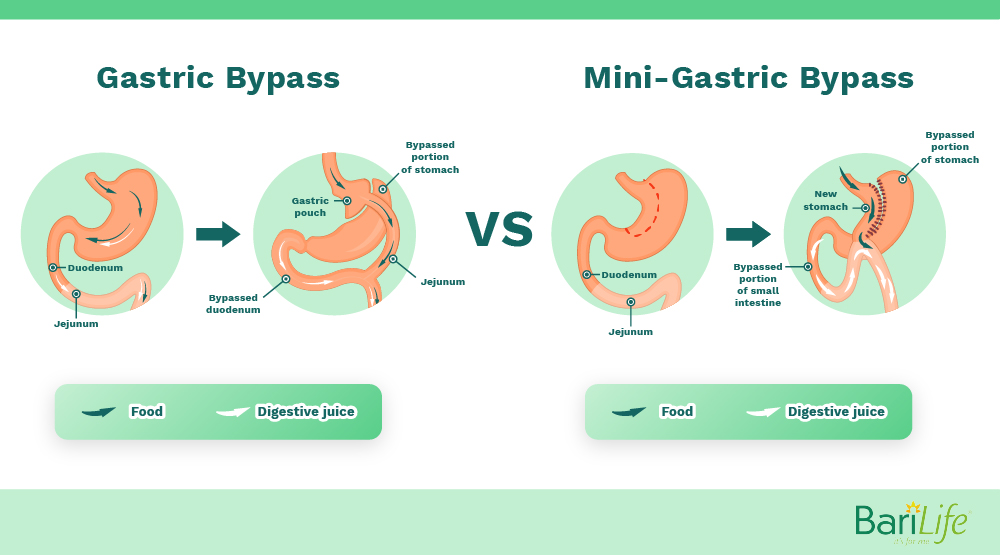
The traditional Roux-en-Y procedure reduces the stomach size to hold about one ounce of food or liquids. The small intestine is then divided to separate the upper and lower parts, known as the duodenum and the jejunum. The new stomach pouch is attached to the lower portion of the small intestine, or jejunum, while the upper portion of the small intestine, or duodenum, is connected further down the small intestine.
That is, two new connections are made. One from the new stomach to the lower small intestine, and another from the upper small intestine to the lower small intestine.
Like the Roux-en-Y, the mini-gastric bypass reduces the stomach. However, the new stomach pouch is somewhat larger, holding a volume of two to five ounces. Rather than dividing the small intestine, the new stomach pouch is attached directly to the jejunum or lower portion of the small intestine. Therefore, only one new connection is made, thus simplifying the gastric bypass procedure.
Let’s take a deeper look at the similarities and differences between the mini-gastric bypass and the Roux-en-Y. When compared to the traditional Roux-en-Y gastric bypass, the mini-gastric bypass offers:
- A shorter operative time
- Fewer temporary or permanent disabilities that occur during the procedure
- Slightly higher long term weight loss rates
- Similar outcomes in resolving metabolic syndrome
- A simpler method to obtain the same if not better results
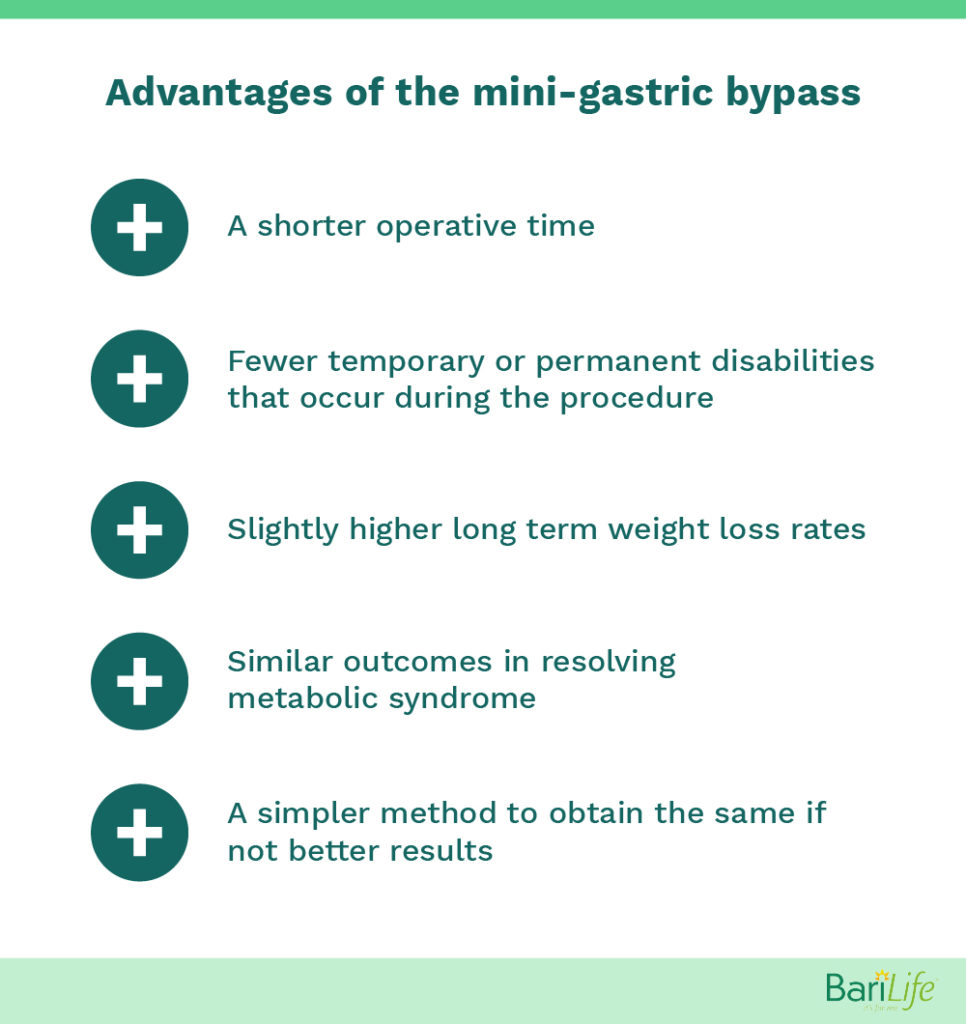
It’s clear that the mini-gastric bypass procedure is a safe and effective contender in the bariatric surgery field. Let’s dive deeper into how much weight you can expect to lose after this procedure and how it compares to other popular weight-loss surgeries.
Weight loss after mini-gastric bypass
How much weight will you lose after undergoing your mini-gastric bypass surgery? To accurately make a determination, we must turn to the research. In most clinical research studies, weight loss comparisons are made by assessing excess body weight lost.
Quick tangent: Excess body weight is basically your current body weight minus your ideal body weight. This leaves us with the extra weight, beyond our ideal body weight, that could be lost safely. For a more detailed understanding of excess body weight, check out this article.
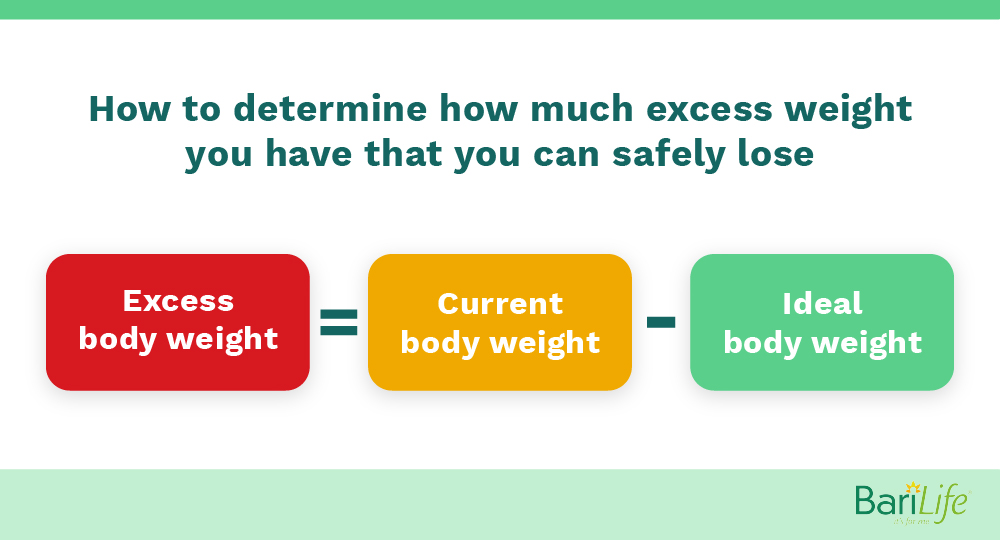
In many studies, the mini-gastric bypass outperforms other bariatric surgeries in long-term weight loss. Let’s compare the two most performed bariatric surgeries, Roux-en-Y gastric bypass and vertical sleeve gastrectomy (VSL), or gastric sleeve, with the mini-gastric bypass.
Excess Body Weight Lost 1 Year Post Op 5 Years Post Op
Mini-Gastric Bypass 69% 73%
Roux-en-y Gastric Bypass 74% 60%
Gastric Sleeve (VSG) 60% 49%
*Excess body weight loss values for mini gastric bypass vary based on reported data
It is pretty clear that the mini-gastric bypass results in the most weight loss long term.
Why isn’t the mini-gastric bypass performed more?
The mini-gastric bypass appears to be a slightly safer bariatric procedure having improved weight loss outcomes. If this is the case, why isn’t it the gold standard in bariatric surgeries?
There are a few reasons:
- There have been significant incidents of bile acid reflux causing ulcers and esophageal damage in individuals that have undergone the surgery
- Long term exposure to reflux poses a risk for cancer
- Revision of the mini-gastric bypass to roux-en-y bypass is needed to correct the reflux
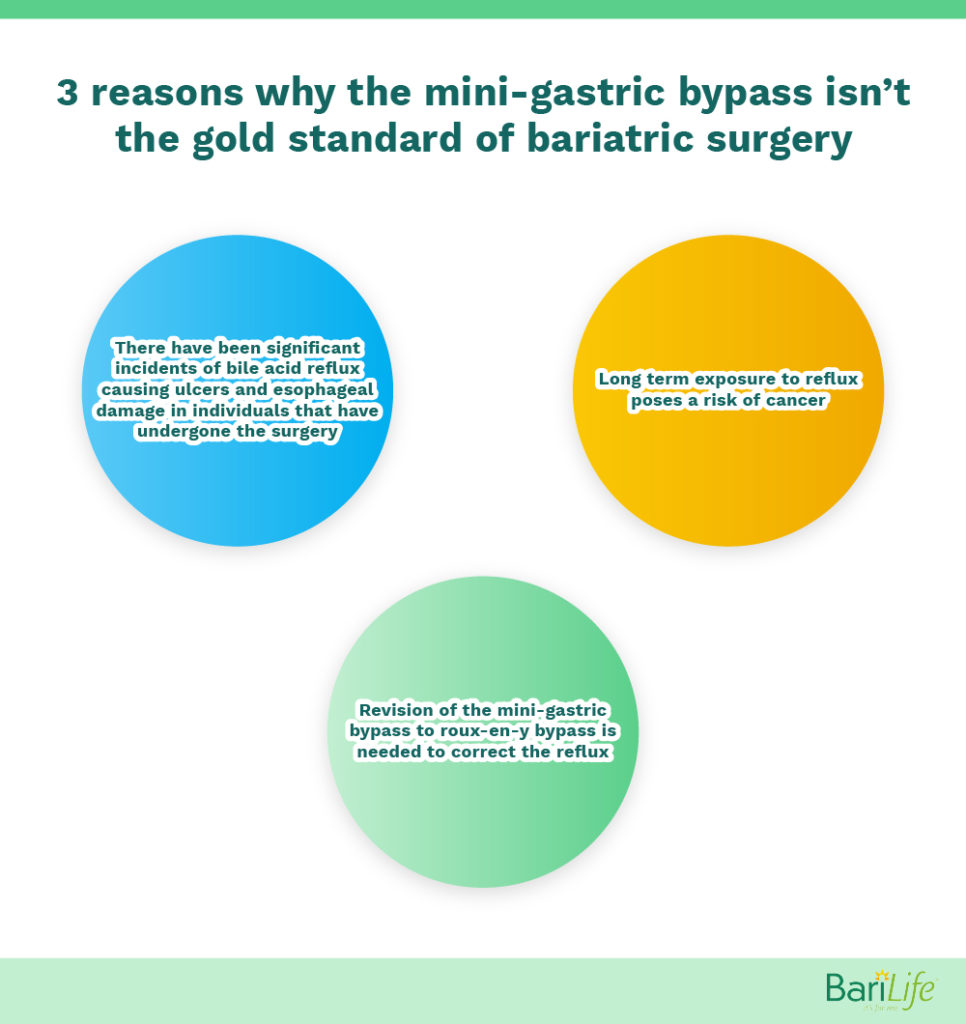
Although these risks are significant, they are less common. It is important to discuss them with your physician prior to making a determination on your bariatric surgery choice.
Additionally, there is the barrier of cost.
Cost of the mini-gastric bypass procedure
The mini-gastric bypass can cost anywhere from $16,000 – $22,000 depending on the state and location of the procedure as well as the physician and hospital in which it is performed. This is significantly less than the average Roux-en-Y bypass which can cost, on average, $18,000 – $35,000. However, much of this cost can be offset with the help of insurance.
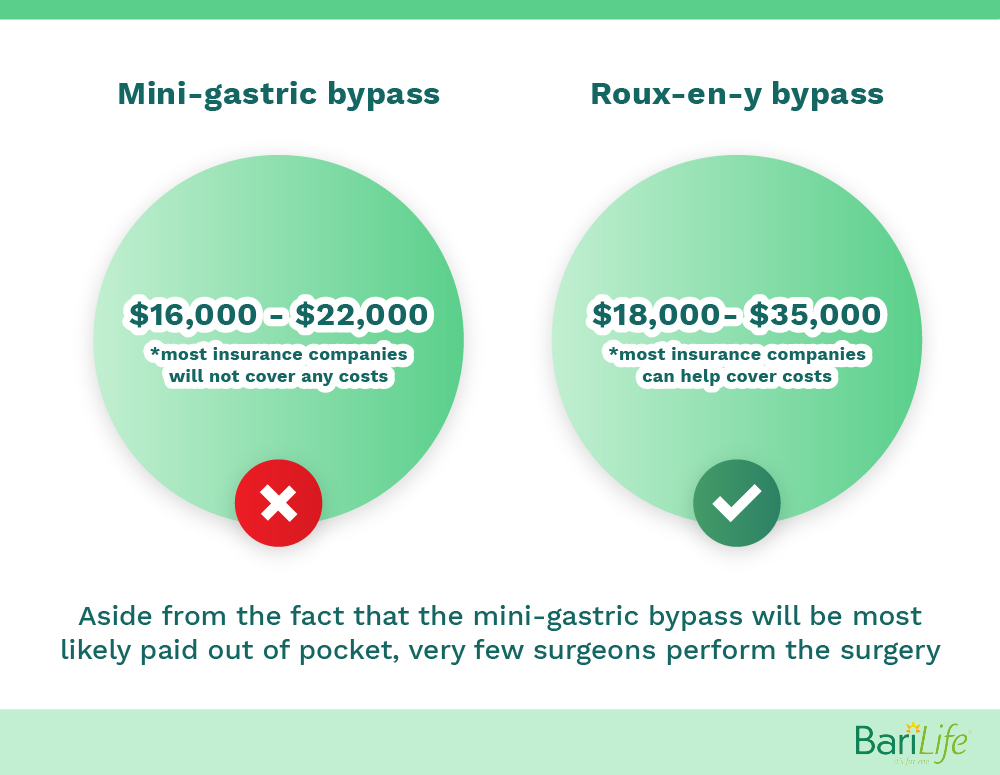
Unlike the traditional Roux-en-Y gastric bypass, most insurance companies will currently not cover the mini-gastric bypass surgery. Coupled with the fact that few physicians perform the surgery, the lack of insurance coverage makes access to the procedure much more challenging for many.
Who should have the mini-gastric bypass?
Because the mini-gastric bypass is not yet performed as routinely as the traditional gastric bypass, the guidelines for who qualifies for the procedure are not as clear. Most often, an individual will qualify for the procedure if they qualify for the Roux-en-y bypass.
To qualify, the candidate should have a Body Mass Index (BMI) over 40. This is considered severe obesity. Surgeons will often perform the procedure on patients with a BMI above 35 if they have other comorbidities such as type 2 diabetes or high blood pressure.
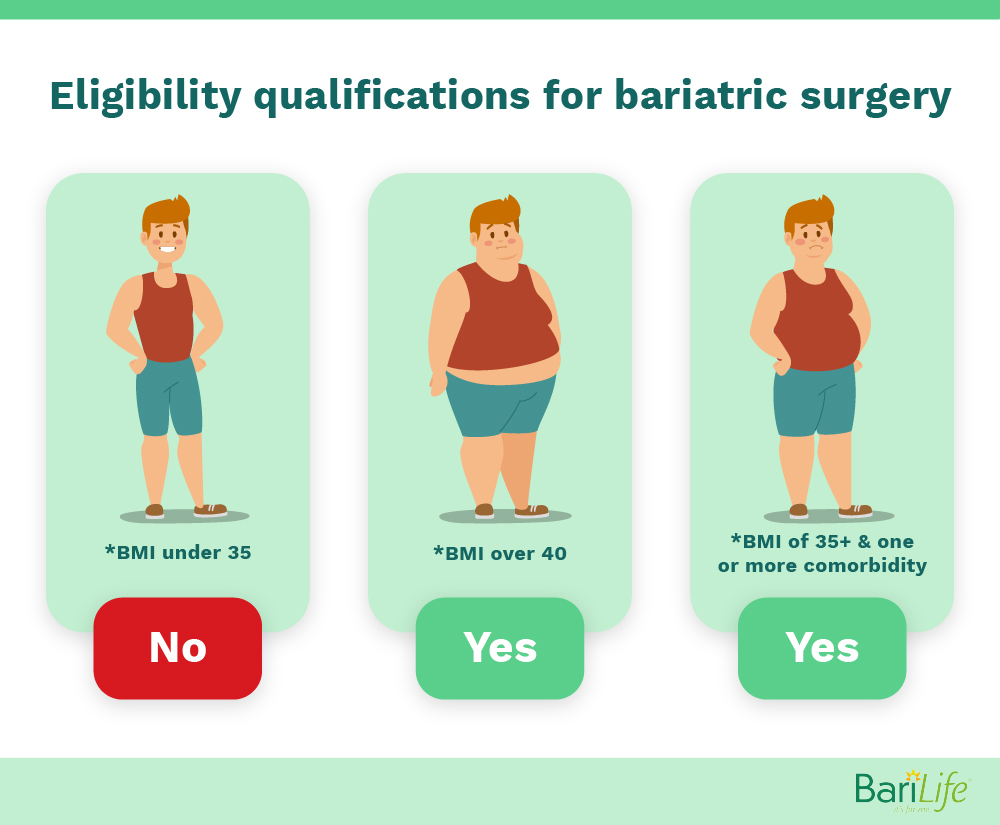
To determine if the mini-gastric bypass is right for you, it is important that you talk to your physician about the risks and benefits associated with the procedure in relation to your specific weight loss journey.
Regardless of your surgical choice, check out BariLife’s wide range of products to satisfy your every craving and nutritional needs both before and after surgery.
In summary
As you have learned, the mini-gastric bypass can be thought of as a simplified version of the traditional Roux-en-y gastric bypass. With a shortened surgical time and decreased surgical complications, it is a promising option for some. However, because of certain risks such as severe biliary reflux as well as the lack of insurance coverage, the mini-gastric bypass is not for everyone.
As always, it is recommended to foster a trusting relationship with your physician in order to determine the best procedure for you or your loved one.




Any weight loss surgery is simply a tool to get us moving in the right direction for weight loss; However, if we do not change our mindset and relationship with food, we will not have any sort of long term success. I had the RNY back in 2007. I lost 135 pounds. In the 13 1/2 years since I have managed to stay within my healthy BMI range but have gained back 25 pounds. I found this website with the 2 week post op bundle and am starting it today to get my portion control back under control along with trying to eliminate cravings for sweets and bad carbs.